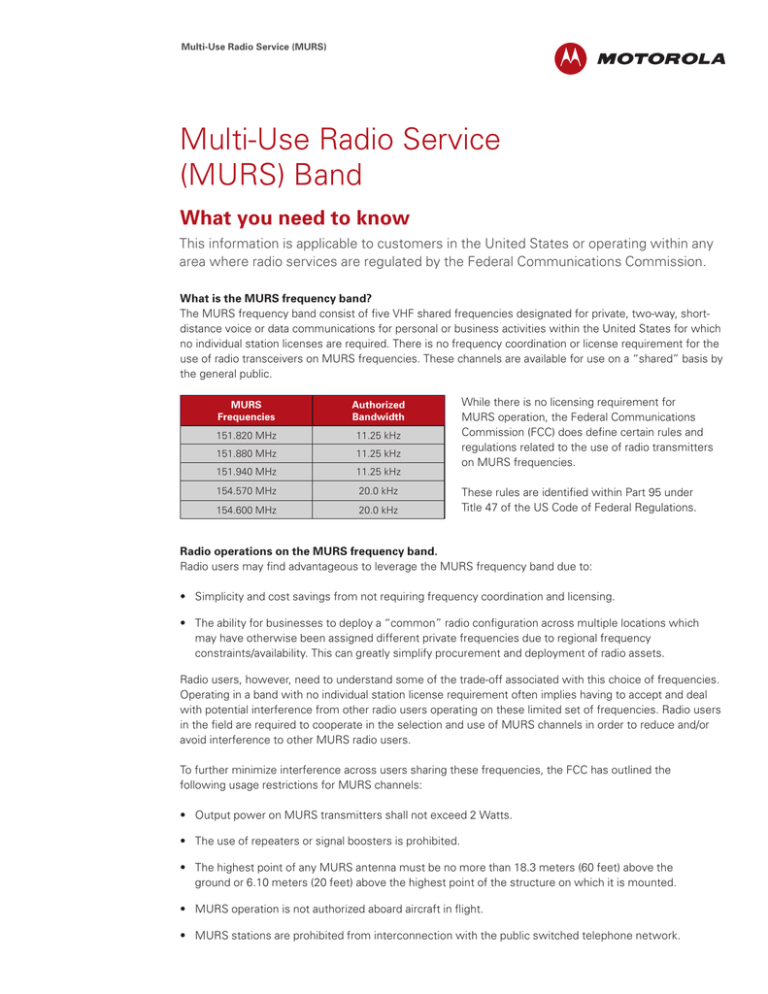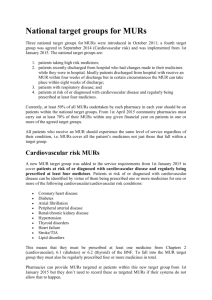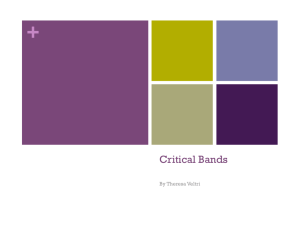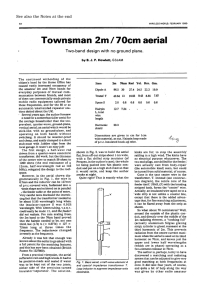
Multi-Use Radio Service (MURS)
Multi-Use Radio Service (MURS) Band
What you need to know
This information is applicable to customers in the United States or operating within any
area where radio services are regulated by the Federal Communications Commission.
What is the MURS frequency band?
The MURS frequency band consist of five VHF shared frequencies designated for private, two-way, shortdistance voice or data communications for personal or business activities within the United States for which
no individual station licenses are required. There is no frequency coordination or license requirement for the
use of radio transceivers on MURS frequencies. These channels are available for use on a “shared” basis by
the general public.
MURS
Frequencies
Authorized
Bandwidth
151.820 MHz
11.25 kHz
151.880 MHz
11.25 kHz
151.940 MHz
11.25 kHz
154.570 MHz
20.0 kHz
154.600 MHz
20.0 kHz
While there is no licensing requirement for MURS operation, the Federal Communications Commission (FCC) does define certain rules and
regulations related to the use of radio transmitters on MURS frequencies.
These rules are identified within Part 95 under Title 47 of the US Code of Federal Regulations.
Radio operations on the MURS frequency band.
Radio users may find advantageous to leverage the MURS frequency band due to:
• Simplicity and cost savings from not requiring frequency coordination and licensing.
• The ability for businesses to deploy a “common” radio configuration across multiple locations which may have otherwise been assigned different private frequencies due to regional frequency constraints/availability. This can greatly simplify procurement and deployment of radio assets.
Radio users, however, need to understand some of the trade-off associated with this choice of frequencies.
Operating in a band with no individual station license requirement often implies having to accept and deal
with potential interference from other radio users operating on these limited set of frequencies. Radio users
in the field are required to cooperate in the selection and use of MURS channels in order to reduce and/or
avoid interference to other MURS radio users.
To further minimize interference across users sharing these frequencies, the FCC has outlined the following usage restrictions for MURS channels:
• Output power on MURS transmitters shall not exceed 2 Watts.
• The use of repeaters or signal boosters is prohibited.
• The highest point of any MURS antenna must be no more than 18.3 meters (60 feet) above the ground or 6.10 meters (20 feet) above the highest point of the structure on which it is mounted.
• MURS operation is not authorized aboard aircraft in flight.
• MURS stations are prohibited from interconnection with the public switched telephone network.
Multi-Use Radio Service (MURS)
Are MURS capable radios the same as those intended for operation on “licensed” frequencies?
No. Equipment designated to operate on MURS frequencies may be similar in look and function as those
designed for licensed frequency operation, however, FCC regulations require the manufacturer to keep
these two technologies separate.
For this reason, Motorola has created unique MURS models such as the RDM Series and CP110m Series
radios. These units are similar to and offer many of the same features as their “licensed” equivalents
(RDX Series and CP110 Series).
Note: Older radio equipment certified in these bands under Part 90 of the FCC rules prior to November
12th 2002 (creation of the MURS band) are permitted operation on MURS frequencies. Newer equipment, however, may only be used on MURS frequencies if the FCC grant reflects Part 95 Subpart J
certification.
Two-Way Radio Frequency Comparison Chart
Unlicensed Operation
Example of popular Motorola
products available for these bands
Licensed Operation
Family Radio Service
(FRS)1
Multi-Use Radio Service
(MURS)
900 MHz
ISM Band
Private Land Mobile Radio Service
Talkabout Series
RDM Series
and CP110m Series
DTR Series
RDX Series, CLS, CP110, BPR40, CP200,
HT750, HT1250, MOTOTRBO, etc.
Part 95
Part 95
Part 15
Subpart B
Subpart J
Subpart C
Very short range
family and business
communications
On-site
business
communications
On-site
business
communications
Maximum allowed output power
(handheld portable radio)
0.5 Watts ERP
2 Watts
1 Watt
Number of available frequencies
for two-way radio communication
14
(UHF)
5
(VHF)
500
(900 MHz FHSS)
Thousands
(VHF, UHF, 800, and 900 MHz)
Repeaters
Allowed
No
No
Yes, under certain
conditions
Yes
Telephone Interconnect
Allowed
No
No
Yes, under certain
conditions
Yes, under certain
conditions
Applicable
FCC Rules
Common
Uses
Part 90
On-site / wide-area
business and industrial
communications
2-6 Watts (depending on the actual frequency)
Family Radio Service (FRS) is not to be confused with General Mobile Radio Service (GMRS). While it is common that FRS radio models also support the GMRS band, these two bands have different applicable rules which need to be considered by the radio user. GMRS requires an FCC license for operation, as of July 31st 1987 new licenses are only available to individuals, not business entities.
1
MOTOROLA, MOTO, Motorola Solutions and the Stylized M Logo are trademarks or registered trademarks
of Motorola Trademark Holdings, LLC and are used under license. All other trademarks are the property of
their respective owners. © 2010 Motorola, Inc. All rights reserved.
R0-04-53




